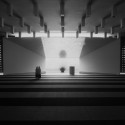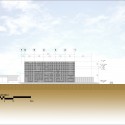Al-Irsyad Mosque / Urbane
Architects: PT. Urbane Indonesia
Location: Kota Baru Parahyangan, Padalarang, Jawa Barat, Indonesia
Principal Architect: M. Ridwan KamilProject Team: Fahry AdhityaClient: PT. Belaputera IntilandSite Area: 8,000 sqmProject Area: 970 sqmProject Year: 2010Photographs: Emilio Photoimagination




A mosque is a place of worship for Muslims—a place to kneel, stoop one's head and pray solemnly. Oftentimes, it is also used to carry out various other religious activities.
The first thing that might catch one's attention about this mosque in Kota Baru Parahyangan (KBP) is the absence of a dome, which is almost always a quintessential characteristic of mosques. However, the architects have informed that the dome is not a cultural/religious identity, hence not a necessity when it comes to designing an Islamic place of worship.
The architecture of the KBP mosque is unique in that it uses stacked stones as the main façade to create tectonic effect, while embedding Islamic text/calligraphy on the façade as a graphic element and reminder prayer.
The primary shape of the mosque takes the form of a square, which seems the most efficient since Muslims pray in straight rows facing a specific direction or the Qiblah.The structural columns are arranged in such way that the façade seems like it is not supported by any frame. This shape also alludes to Ka'bah, the most important structure in the Islamic world, to which all Muslims' prayers are directed.
The tall pole-like structure next to the square building form is called the minaret, an important element for mosque. It was used in the past for someone to call out to all Muslims to prayer on top of the minaret whenever prayer time has come. Today, the minaret still serves the same function, except loudspeakers a– used instead. In a way, the minaret has become an icon of mosques; anyone searching for a mosque can one from afar.
With a capacity to accommodate approximately 1,000 people, the mosque is also designed to 'blend in' with nature. The stacked stones allow for natural ventilation without the need for air-conditioning. Surrounded by water, the ambient temperature around the mosque will be lower during the hot season. Once inside, the people are able to look out and appreciate the external scenery.
Location: Kota Baru Parahyangan, Padalarang, Jawa Barat, Indonesia
Principal Architect: M. Ridwan KamilProject Team: Fahry AdhityaClient: PT. Belaputera IntilandSite Area: 8,000 sqmProject Area: 970 sqmProject Year: 2010Photographs: Emilio Photoimagination




A mosque is a place of worship for Muslims—a place to kneel, stoop one's head and pray solemnly. Oftentimes, it is also used to carry out various other religious activities.
The first thing that might catch one's attention about this mosque in Kota Baru Parahyangan (KBP) is the absence of a dome, which is almost always a quintessential characteristic of mosques. However, the architects have informed that the dome is not a cultural/religious identity, hence not a necessity when it comes to designing an Islamic place of worship.
The architecture of the KBP mosque is unique in that it uses stacked stones as the main façade to create tectonic effect, while embedding Islamic text/calligraphy on the façade as a graphic element and reminder prayer.
The primary shape of the mosque takes the form of a square, which seems the most efficient since Muslims pray in straight rows facing a specific direction or the Qiblah.The structural columns are arranged in such way that the façade seems like it is not supported by any frame. This shape also alludes to Ka'bah, the most important structure in the Islamic world, to which all Muslims' prayers are directed.
The tall pole-like structure next to the square building form is called the minaret, an important element for mosque. It was used in the past for someone to call out to all Muslims to prayer on top of the minaret whenever prayer time has come. Today, the minaret still serves the same function, except loudspeakers a– used instead. In a way, the minaret has become an icon of mosques; anyone searching for a mosque can one from afar.
With a capacity to accommodate approximately 1,000 people, the mosque is also designed to 'blend in' with nature. The stacked stones allow for natural ventilation without the need for air-conditioning. Surrounded by water, the ambient temperature around the mosque will be lower during the hot season. Once inside, the people are able to look out and appreciate the external scenery.
- © Emilio Photoimagination
- © Emilio Photoimagination
- © Emilio Photoimagination
- © Emilio Photoimagination
- © Emilio Photoimagination
- © Emilio Photoimagination
- © Emilio Photoimagination
- © Emilio Photoimagination
- © Emilio Photoimagination
- © Emilio Photoimagination
- © Emilio Photoimagination
- © Emilio Photoimagination
- floor plan
- elevation 01
- elevation 02
- section 01
- section 02
- façade detail 01
- façade detail 02
- façade detail 03
- wall details























تعليقات
إرسال تعليق